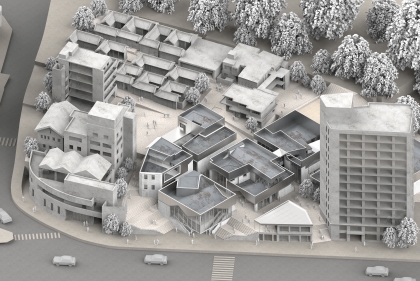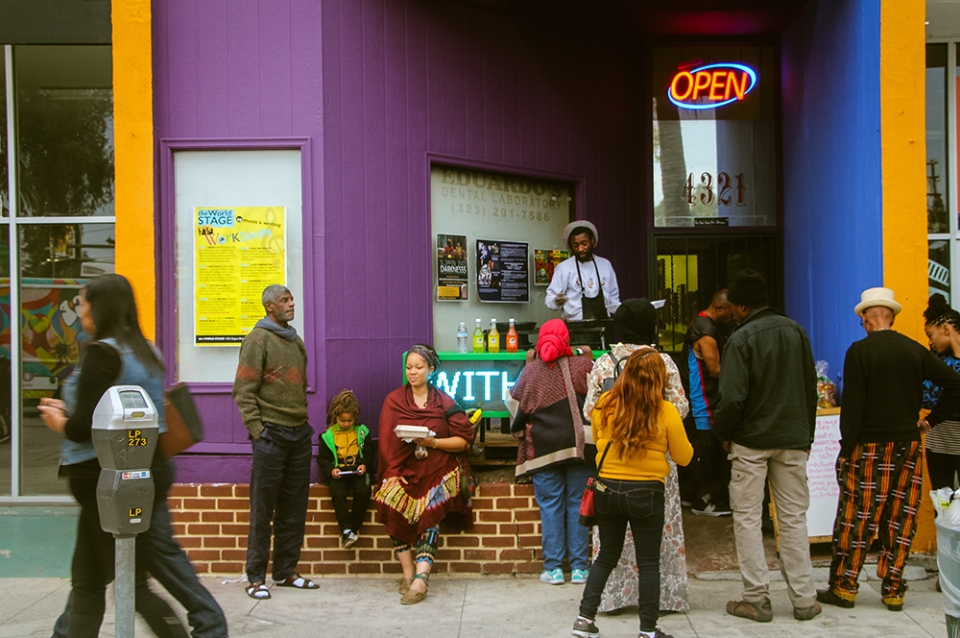November 14, 2018
Stuart Weitzman School of Design
102 Meyerson Hall
210 South 34th Street
Philadelphia, PA 19104
Get the latest Weitzman news in your Inbox
Media Contact
Michael Grant
mrgrant@design.upenn.edu
215.898.2539
In the introduction to Matt Miller’s 2018 dissertation, The Geography of Black Commerce and Culture, there’s a portrait of Georgette Powell, the owner of a Los Angeles restaurant called Mel’s Fish Shack, leaning on a counter in front of her kitchen with her head cocked to the right, smiling.
“I know I could afford to move the business to a more profitable location...,” Powell tells Miller, who also filmed her for the interview. “But I refuse to leave this community.”
For Miller, a postdoctoral fellow in the Department of City and Regional Planning, stories like Powell’s are what drives his research. What kinds of neighborhoods do black businesses thrive in? How do black entrepreneurs envision the development of their communities? What kinds of economic benefits are associated with the clustering of black businesses? What does black urbanism look like?
“That’s been my main thing,” Miller says. “Trying to explore black urbanism as a theory and understand the way black culture informs the built environment and urban spaces.”
Miller is a Bay Area native, with a master’s degree in city planning from MIT and a Ph.D. from the University of Southern California. But his pedigree isn’t just academic. He also comes from a “family of creatives”—his mother is a writer and an actor and his siblings are artists, photographers, and singers. So his research methods are varied, combining quantitative practices with storytelling and photography.
“I’m a planner by training but I guess I’m an artist at heart,” says Miller, who posts photographs of L.A. and Philadelphia on his Instagram account, @BlackUrbanism. “Being in a school of design, I think, is a great nexus for me. To be able to explore some of the questions around cultural vitality and placemaking is a big area of interest, particularly in communities of color.”
At PennDesign, Miller is working on publishing various work related to his dissertation: There were so many research methods in the study that each chapter has the potential to be developed into its own separate work, he says. And next semester, he’s teaching a class called “Place, Taste and Urban Change” that he co-developed at USC.
“This one is a bit more reflective and really probing, asking questions around: What does artistic excellence look like in placemaking activities? Who gets to define what artistic excellence is? And how does placemaking relate to urban revival and change?” he says.
Vincent Reina, Assistant Professor of City and Regional Planning and Miller’s postdoctoral advisor, says that Miller’s varied methodology is a good fit for an interdisciplinary program like PennDesign.
“Matt’s research and methods are innovative and interdisciplinary, which allows him to develop meaningful connections between community and economic development, design, communication and a broad set of fields,” Reina says.
For now, Miller is based in North Philadelphia, where he spends time talking with black business owners about their relationship to their neighborhood. He says he hasn’t lived anywhere else with such a wealth of historic black institutions—places like Barber’s Hall and the Uptown Theater—and through conversations with preservation faculty at Penn, he’s begun to think about putting together walking tours. And he’s considering completing a study looking at hotspots for black businesses around the country, past and present.
Overall, Miller says, conversations about urban black communities are mostly focused on the “deficits” of being black in the city—the very real structural disadvantages that black communities face in the United States. But in his research on black entrepreneurs, Afrofuturism, and black urbanism, he’s brought a focus to the cultural and economic power that can be found in those same communities.
“The big, hairy, audacious goal is to really reframe blackness, and possibly even ethnicity and race more broadly, as a cultural resource, to beautify and fortify belongingness in the city for people of color,” Miller says.
While Miller looks for a long-term post, his postdoctoral fellowship could last up to three years. Lisa Servon, professor and chair in the department of city and regional planning, says the school is “lucky to have him on board.”
“We have a lot of strength in housing, community and economic development in our department,” Servon says. “Matt’s work in creative placemaking gives us even greater depth in this area. And his focus on race and intersectionality fits perfectly with our focus on equity.”
Editor’s note: Miller’s appointment at PennDesign was made possible by the Penn Postdoctoral Fellowships for Academic Diversity, a competitive program to increase the diversity of the community of scholars devoted to academic research at Penn. In addition to Miller, Akira Drake Rodriguez was appointed to the Department of City and Regional Planning through the program. Her research examines the politics of urban planning and the ways that disenfranchised groups re-appropriate their marginalized spaces. Visit the Diversity at PennDesign web page for more on these initiatives.


 Expand Image
Expand Image

